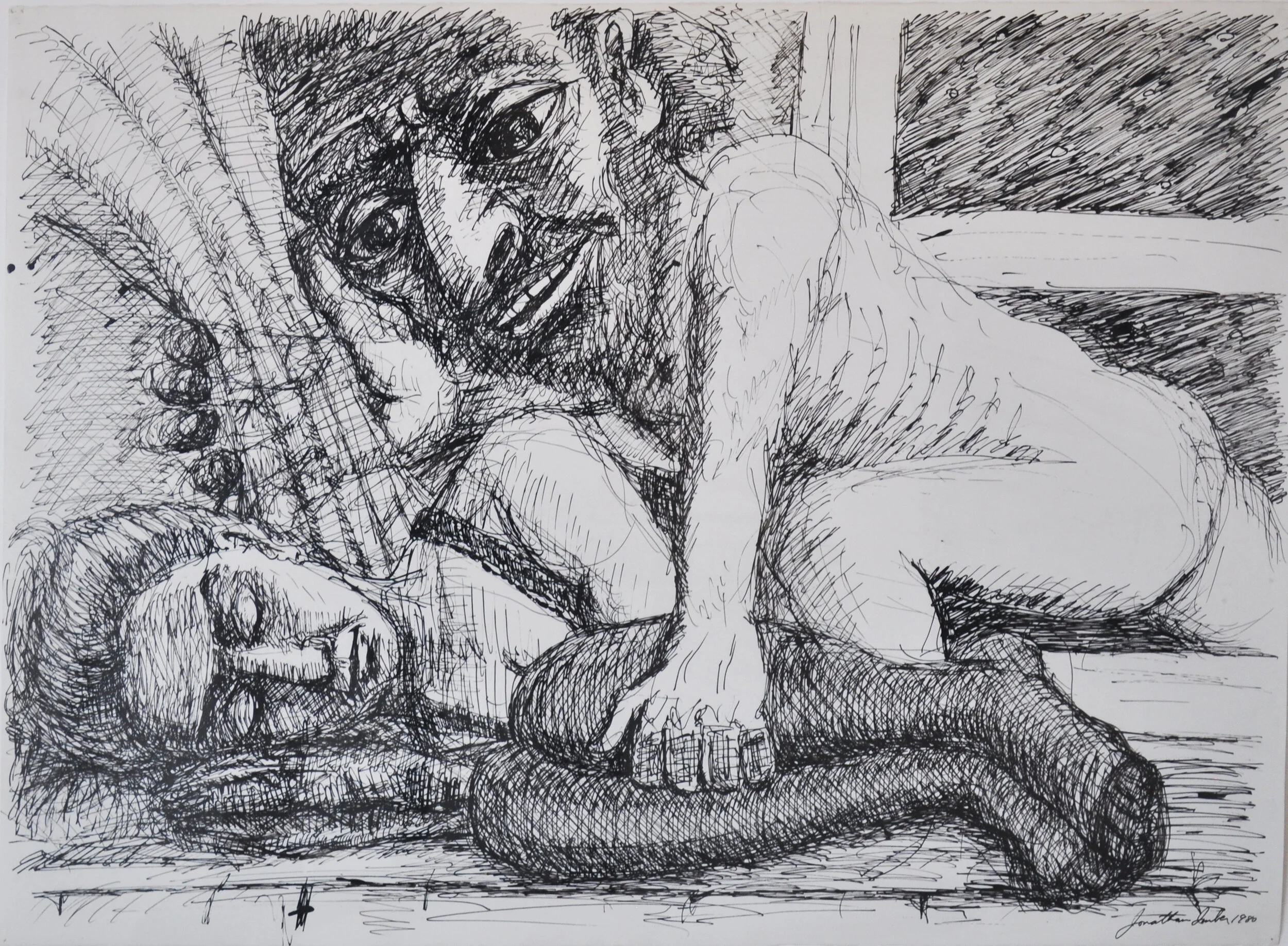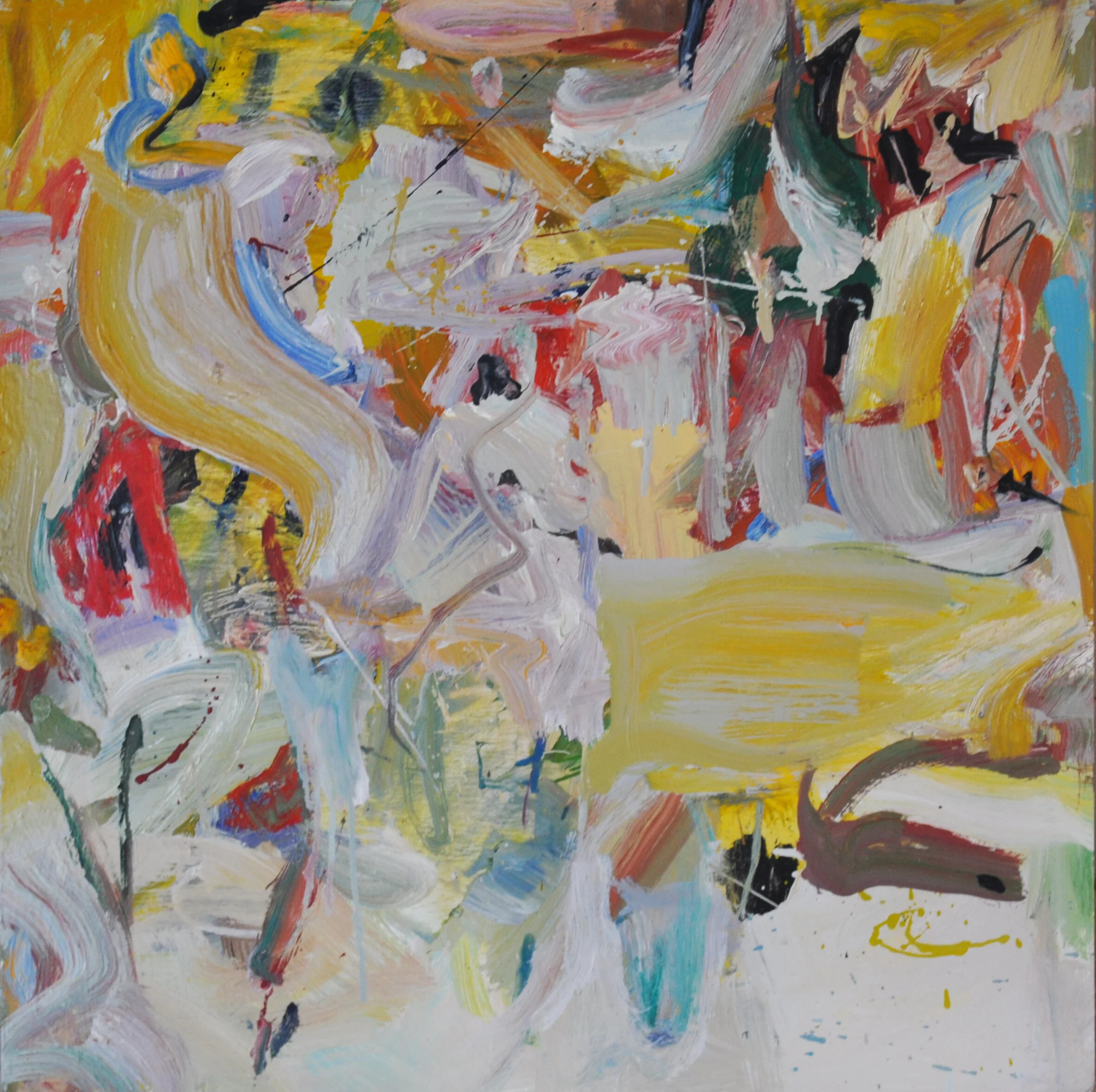Jon Imber Retrospective
Jon Imber, After de Kooning (2009)
August 6 - October 10, 2020
A career-spanning retrospective of work by the late nationally respected Boston and Maine based painter, Jon Imber (1955-2014), of whom Pulitzer Prize winning art critic Sebastian Smee wrote: Imber has wrestled with different influences, different styles, and different subject matter all his life. The shifts in his case, have felt less tectonic than nimble, supple, full of yearning and mischief. Life, in Imber’s paintings, unfurls with wayward force, like a thick, flicked rope. It takes on vital cadences. It laughs at itself, too. All of Imber’s evolving styles and subject matter are represented in this exhibition — from his earliest figurative paintings and portraits (1980’s), to his studio and plein air landscapes (1990’s), to his later nearly abstract work (2000’s on). And finally, the poignant “goodbye” portraits of family and friends he made in the years leading up to his premature death of ALS in April of 2014.
* * *
Jon Imber (1950-2014) was born in Baldwin, New York in 1950, and received a BFA from Cornell in 1972. Though abstraction had been the prevailing movement in American Modernism since World War II, Imber was drawn to painting the figure and to the alternate approach being taken by artists associated with the Boston Expressionist movement. So for graduate school, Imber chose Boston University, with an intention to study with Philip Guston and Jim Weeks. Imber has noted that, at the time, “few other places in the country demonstrated a strong interest in the great traditions; no other school offered life drawing as a basis for departure.” Earning his MFA in 1977, Imber studied under and became close friends with Philip Guston, whom he came to consider a “second father.”
Though later in his career, in somewhat of a reversal of his mentor, Guston’s, trajectory, Imber fully embraced landscapes and abstraction (the style he is best known for), early on, he remained a figurative painter. His early works are notable for what Boston Globe art critic, Cate McQuaid characterized as “hulking, volumetric figures with tiny strokes... a strange, striking blend of Romanesque art and blocky, cartoonish figures executed with brushy, fastidious mark-making akin to Van Gogh’s.” Katherine French, former director of Danforth Art, an institution housing a large collection of Boston Expressionist works, deemed Jon Imber “one of the most important painters of his generation,” placing him firmly in the lineage of Boston Expressionists, who were notable for the emotional content and the emphasis they placed on paint itself — not as just as color, but as an integral and meaningful element of their work.
Across the span of his career, Imber was a notably fearless painter. The type of artist who thrives on risk — needing, in fact, to take risks to stay interested. His focus shifted to portraits, then to large, studio landscapes, then to figures in landscapes, then to plein air landscapes, and finally to landscapes and still lifes veering further and further into abstraction, with his brushstrokes growing ever more lush, bold, and dashing. The work of Guston, as well as other favorite artists such as Max Beckmann, Willem de Kooning, Marsden Hartley, Picasso, Cezanne, and Alice Neel, inform Imber’s art, and their influences can be seen through the evolution of Imber’s style. But, ultimately, as with all true masters, Imber’s work is uniquely and distinctly his own, and within these changes, Jon Imber maintained a unique highly gestural style and an intimate sense of “knowing” his subjects beyond observation. His signature style is energetic and immediate, marked by its embrace of color and of brushstrokes applied with verve and aplomb. As Boston Globe art critic Sebastian Smee has written, “The paintings of Jon Imber have an unusually insistent pull — you feel something vital at stake.”
After experiencing a sort of stylistic “breakthrough” during a visit to Ireland in the early 2000’s, painting a seascape while ill with a fever, Imber began to favor broader brushstrokes and thicker application of paint, occasionally utilizing a palette knife. Upon his return home, paintings of the environs surrounding his longtime summer home in Stonington, Maine, where he lived with his wife, painter Jill Hoy, and his son Gabriel, grew increasingly abstract, airier and looser. The artist’s lifelong love of de Kooning became more present in the work, though as always, Imber’s style remained distinctive. Imber paintings are, as Cate McQuaid puts it: “audacious, opalescent, deeply felt, keenly investigating the limits of space.” Pulsing with color and energy, and composed of an array of deft, calligraphic brushstrokes, they evoke the sensory experience of a specific time and place. Imber enjoyed the demands and urgency of painting on site, where the changing light and atmosphere require a rapid execution. “It’s a good match to my temperament,” he has said. “I like the challenge of looking at something familiar and reinterpreting it, coming up with something new.”
Jon Imber’s fearlessness — his unsinkable zeal for life and his passion for painting — are perhaps best exemplified in the way he embraced life and his work in his final years. Soon after being diagnosed with ALS in the fall of 2012, Imber lost the use of his dominant right hand. So he wasted no time in teaching himself to paint all over again, with his left hand. And when the muscles in both arms began to fail, he painted with a brush attached to one of the fingers of his left hand. Imber described his left-handed paintings as “really tough and really expressive…there was no leaning on facility….I have no way I can do anything but kind of raw, expressive gestures. And I’m very proud of it. It’s what I always wanted in painting.” When his condition deteriorated too much to allow him to paint on location, he began painting portraits of friends, family, and local Deer Isle residents who came to visit him in his studio. When he ultimately lost the use of his left hand as well, he continued to paint, experimenting with a brush attached to a metal brace on his forehead and, eventually, with both hands held together holding the brush at his waist. Through it all, Imber never lost his wit or his occasionally dark sense of humor. Despite the physical limitations caused by ALS, he remained a prolific painter until his death at age 63 in 2014. In his final year, Imber created 100 paintings in a four-month span. That year, he was also featured in several museum and gallery exhibitions, and he showed up at all the openings. His prolific output and enthusiastic participation in the art world and in life itself were, in his widow, Jill Hoy’s words: “…part of an almost voracious desire to leave the earth with a big splash.”
Imber's paintings are held in numerous collections and museums around the U.S., including the Museum of Fine Arts Boston, Harvard's Fogg Museum, the New Orleans Museum of Art, the DeCordova Museum, the Farnsworth Museum, the Danforth Museum, the Houston Museum of Fine Arts, the Bowdoin College Museum of Art, the Davis Museum at Wellesley, and the Rose Art Museum at Brandeis. He was the subject of a 2014 retrospective at the Godwin-Ternbach Museum at Queens College in New York.
Jon Imber was the recipient of numerous awards and fellowships, including two National Endowment for the Arts fellowships, a Massachusetts Artists fellowship, an AVA award, an Engelhard Foundation award, the National Academy Museum's Altman Award, Boston University's Distinguished Alumni Award, two grants from the Massachusetts State Arts Lottery, and a Ballinglen Arts Foundation fellowship. His work has been included in many publications including Paintings of Maine: A New Selection by Carl Little and Boston Modern: Figurative Expressionism As Alternative Modernism by Judith Bookbinder. Imber’s courageous and inspiring battle with ALS is the subject of Richard Kane’s multiple award-winning 2014 documentary, Jon Imber’s Left Hand.
Jon Imber taught at Harvard for 27 years and also taught for many years at the Rhode Island School of Design. He lived in Somerville, Massachusetts and Stonington, Maine.
Art Review: https://hyperallergic.com/592635/jon-imber-retrospective-at-cove-street-arts/
Preview the Exhibition
(CLICK IMAGE TO ENLARGE; CURSOR OVER ENLARGED IMAGE FOR DETAILS)










































